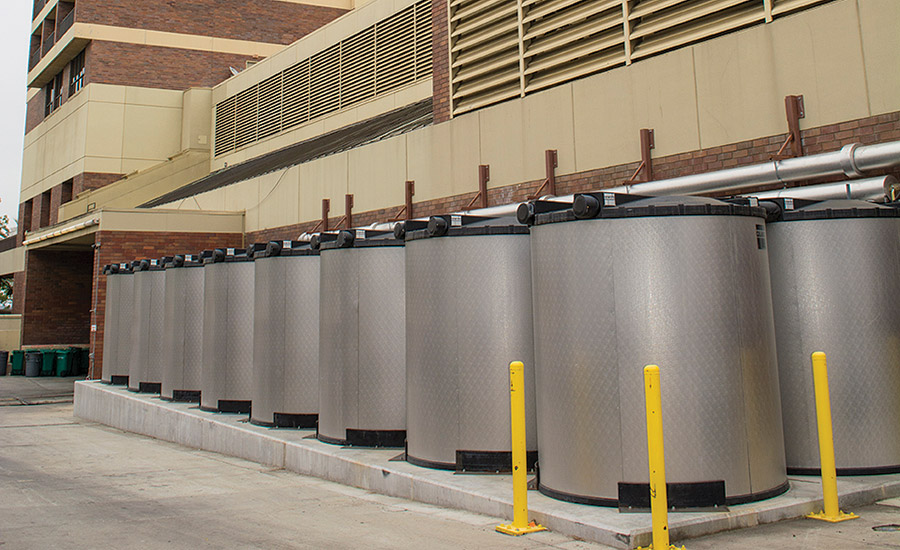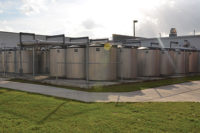As a luxury resort, comfort is a top priority for Pacific Palms Resort. However, the resort, situated on the outskirts of Los Angeles, was in need of an energy-efficient and sustainable HVAC solution.
With an aging central chiller plant original to the facility and responsible for cooling 415,000 sq ft and boilers, and cooling towers that needed to be replaced, Pacific Palms Resort knew that an upgrade to this equipment would improve system reliability and energy costs, benefiting both staff and guests.
The resort’s operations team worked closely with a team from Trane to come up with an HVAC retrofit that would meet the needs of a luxury resort and included the use of ice-based energy storage. As part of the decisionmaking process, Mike Toth, Pacific Palm Resort’s director of engineering, toured an ice storage system in Minnesota and was so impressed with the real numbers that he wanted to replicate the same savings that the facility was generating.
After the research was complete, the final solution consisted of three main components: Tranes’s chillers, free cooling, and the implementation of an ice plant composed of Calmac’s IceBank® thermal energy storage tanks. The combination of these technologies would provide necessary flexibility in how the system could operate, add redundancy to improve reliability, and generate energy cost savings through load shifting. In order to optimize savings from these components, Tranes’s Tracer™ SC BAS was selected to enable plant operators to monitor equipment and make changes from their PCs, tablets, or mobile phones.
A 500-ton Trane centrifugal chiller was chosen for the project due to its variable speed drive, designed to operate as quietly as possible with lower energy use. In addition, the chiller plant was upgraded with new chilled water and condenser water pumps (also with variable speed drives) and chiller sequencing strategies. A separate Trane screw chiller was chosen to operate with the Calmac IceBank tanks, which are capable of providing over 300 tons of cooling.
Economizer dampers on the air handlers enable the use of free cooling when outdoor conditions permit.
When the new chiller plant was originally designed, Pacific Palms Resort was purchasing its electricity from Southern California Electric (SCE), which uses a Time of Use (TOU) rate structure. The plan at that time was to utilize the thermal energy storage tanks to create ice at night when energy prices were at their lowest. The next day, the ice would be melted, or discharged, to cool the facility when energy prices were at their highest. However, during the project, power from the supplier changed from SCE to Industry Power, which implements a flat rate structure.
After analyzing the new pricing structures, it was determined that it would be financially beneficial to focus the use of the energy storage tanks on shaving the facility’s peak load — times of highest energy use — in order to reduce peak demand. This strategy would lower peak demand costs and tariffs implemented by the new utility, while the flexibility would allow Pacific Palms Resort to manage the system in ways that best suit their energy loads. For example, the resort can discharge the tanks in order to offset the demand created by charging golf carts after the course has closed. On hot humid days, ice storage could help chillers meet cooling loads. The stored energy can be used to manage the resorts electric demand to optimize cost savings based upon the supply tariffs.
During the summer months of 2015, the resort was able to reduce its peak electrical demand by roughly 46% in June, 43% in July, and 44% in August.
“Using Calmac’s ice-based energy storage tanks have allowed us to save between $10,000 and $15,000 per month in energy costs,” said Mike Toth. “The system can be used in a variety of ways. For instance, during maintenance projects loads can be switched to the tanks and other equipment can be temporarily taken offline. With the energy-efficient chillers, free cooling and energy storage in place, the resort has triple protection to ensure guests are comfortable.”
Even with changing utility rates, the ice-based energy storage tanks haven proven a valuable asset after slight changes in strategy and operating schedules were made. The upgrades that Pacific Palms Resort’s HVAC system has undergone drastically increased the facility’s return on investment for decades to come, without sacrificing occupant comfort.
“Hotels and resorts are often made up of rooms and sections that can operate very differently,” said Mark MacCracken, CEO of Calmac. “Understanding how your energy is billed and the usage patterns of your facility is vital for identifying how loads can be shifted and energy costs can be cut. Pacific Palms Resort has done a great job of this, and it has been highly beneficial. The sustainability initiatives have been impressive.”



